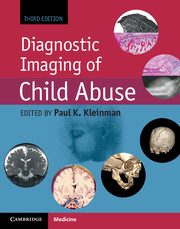Book contents
- Frontmatter
- Dedication
- Contents
- List of Contributors
- Editor’s note on the Foreword to the third edition
- Foreword to the third edition
- Foreword to the second edition
- Foreword to the first edition
- Preface
- Acknowledgments
- List of acronyms
- Introduction
- Section I Skeletal trauma
- Section II Abusive head and spinal trauma
- Section III Visceral trauma and miscellaneous abuse and neglect
- Section IV Diagnostic imaging of abuse in societal context
- Section V Technical considerations and dosimetry
- Index
Section II - Abusive head and spinal trauma
Published online by Cambridge University Press: 05 September 2015
- Frontmatter
- Dedication
- Contents
- List of Contributors
- Editor’s note on the Foreword to the third edition
- Foreword to the third edition
- Foreword to the second edition
- Foreword to the first edition
- Preface
- Acknowledgments
- List of acronyms
- Introduction
- Section I Skeletal trauma
- Section II Abusive head and spinal trauma
- Section III Visceral trauma and miscellaneous abuse and neglect
- Section IV Diagnostic imaging of abuse in societal context
- Section V Technical considerations and dosimetry
- Index
Summary
The six chapters that comprise the Abusive head and spinal trauma section of the third edition of Diagnostic Imaging of Child Abuse represent an interdisciplinary collaboration by six experts, working as a team under the guidance and deep dedication of Gary L. Hedlund, DO. In the section the elements of scholarly thought, in-depth literature review, and research merge with decades of cumulative clinical experience to produce a body of work that exhibits a balance of evidence-based medicine (EBM) and practice-based evidence.
The contributing authors in their given specialties lecture nationally and internationally and have published many chapters, syllabi, and peer-reviewed papers on abusive head and spinal trauma, as well as other aspects of child abuse.
The section begins with the fundamental biomechanical and clinical considerations that relate to abusive head trauma (AHT) (Chapter 16). It moves on to imaging with a discussion of inflicted trauma to the scalp, subscalp, and cranium (Chapter 17), followed by chapters on the intracranial manifestations of AHT (Chapters 18, 19). The discussion of AHT concludes with a chapter on imaging guidelines for suspected AHT (Chapter 20). The section wraps up with an in-depth presentation of craniocervical junction and spinal trauma (Chapter 21).
All the authors of the section wish to acknowledge Lucy Rorke-Adams, MD and Mark R. Proctor, MD for their valued neurosurgical and neuropathologic input in Chapters 17, 18, 19, and 21.
- Type
- Chapter
- Information
- Diagnostic Imaging of Child Abuse , pp. 343 - 344Publisher: Cambridge University PressPrint publication year: 2015



